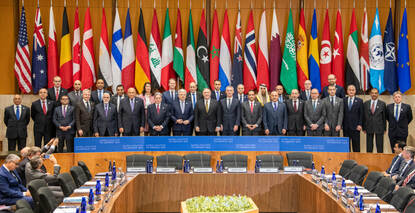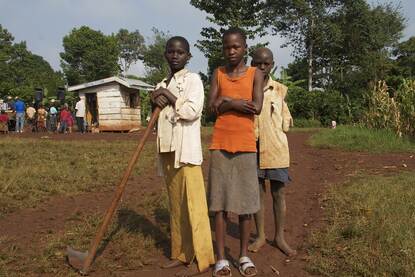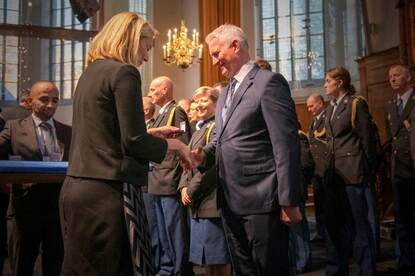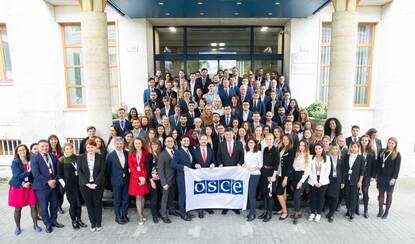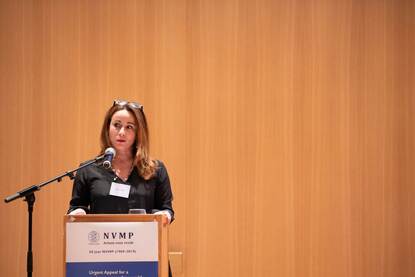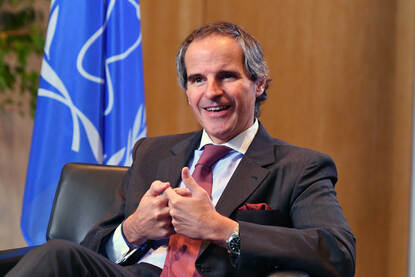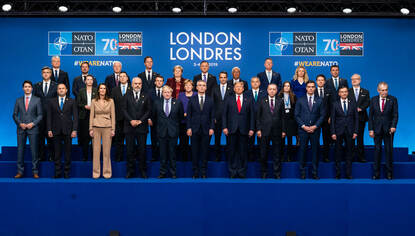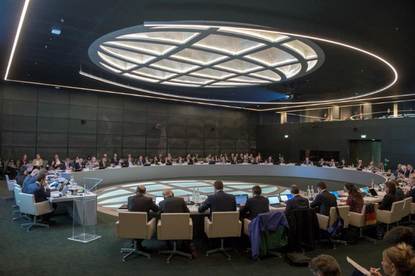Tekst Daniël Schepers
Eind november vond er in het Vredespaleis in Den Haag een congres plaats, georganiseerd door het NVMP, een organisatie van artsen die zich inzetten voor vrede. Het onderwerp van dit congres was een kernwapenvrije wereld. Naast gasten als minister Blok en Hoog Vertegenwoordiger van de VN Izumi Nakamitsu was ook Eirini Lemos-Maniati aanwezig. Zij is de adjunct-directeur voor ontwapening, wapenbeheersing en non-proliferatie van de NAVO. De Veiligheidsdiplomaat ging met haar in gesprek over de rol van NAVO bij wapenbeheersing, de uitdagingen en successen van de NAVO op het gebied van wapenbeheersing en hoe je optimistisch blijft als veiligheidsdiplomaat in een wereld waarin multilaterale verdragen niet zo weerbaar lijken te zijn als voorheen. Zo vertelt de adjunct-directeur over de noodzaak van samenwerking tussen militaire, technische en diplomatische experts en over de verschillende manieren waarop NAVO haar bondgenoten helpt bij hun wapenbeheersingprogramma’s. Benieuwd wat mevrouw Lemos-Maniati allemaal te vertellen had? Lees snel het (Engelstalige) interview hier.
NATO is primarily a collective defense organization. What is the significance of arms control, disarmament and non-proliferation (ADN) of WMDs to NATO given this primary role; how do these topics fit in the mission statement of NATO?
Indeed, NATO is a collective defense organization, and Allies view arms control, disarmament, and non-proliferation (conventional and WMD) as important contributors to Allied security. NATO’s core approach to security is two-pronged – strong deterrence and defence, aligned closely with dialogue. This two-pronged approach has reaped huge rewards. It created the security and political conditions necessary for the arms reduction agreements, including treaties such as INF, CFE, START, and New START. These treaties, as well as the Open Skies Treaty and Vienna Document, supported the massive reduction of conventional and nuclear arsenals, including the reduction of forward-deployed nuclear weapons assigned to the defense of the Alliance down more than 90 percent from their peak at the height of the Cold War.
What is NATO’s contribution to worldwide efforts of ADN? What does NATO do that individual countries cannot?
NATO has contributed to arms control efforts since 1957, when we submitted our first disarmament proposal in London. NATO provides Allies with a platform for political engagement, as well as military, intelligence, and technical engagement, across all aspects of security – because, as we should remember, ADN is not best served by discussions among diplomats alone. You need military officials to discuss hard security, intelligence experts to describe facts as they are, technical experts to tell you what is possible and not possible within ADN, and then the diplomats to negotiate on that firm logical basis.
At the same time, Allies jointly call on countries such as Russia and North Korea to comply with their international arms control commitments and stop violating their agreements or proliferating dangerous weapons and technologies. We also support each other as we negotiate arms control agreements in other bodies. We develop common positions and language, so we can speak in unison on arms control – just as we do on other aspects of security policy. We also use NATO to help coordinate the implementation of our common commitments under existing arms control regimes. For example, Allies work together at NATO to ensure that we comply with our conventional arms control obligations under the CFE Treaty, the Open Skies Treaty, and the Vienna Document. NATO also offers a platform for Allies and partners to tackle arms control and disarmament challenges together. We also engage with partner nations and international organizations on ADN matters. Many of our partners see NATO as an important and credible player in this area that brings together European and North American Allies, united in interests and values.
How have you experienced the collaboration with the Dutch MFA? What role specifically do Dutch diplomats and civil servants play in the broader ADN agenda of NATO?
Simply excellent. I have had the honor and the privilege to have worked under the leadership of the previous Secretary General Jaap de Hoop Scheffer, and his outstanding private cabinet officers, Ambassador Ed Kronenburg and Ambassador Henne Schuwer. Jaap de Hoop Scheffer was a true multilateralist, with clear understanding of the importance of NATO’s relations with other organizations. It was under his leadership that we concluded in 2008, the first ever Joint NATO-UN Declaration and enhanced the institutional relationship, to complement the existing co-operation in the field. As for his Directors, both diplomatic giants, in the true sense of the word. So throughout my career, I have always had the pleasure of working with outstanding Dutch diplomas, both in my current position with your outstanding Ambassador Marisa Gerards, but also in my previous ones as the SG’s Representative for the OSCE as well as the when I headed the NATO Liaison Office in New York. I always admired the clear-head approach to issues and always a very constructive engagement. And perfect negotiators, especially the current Ambassador for Non-Proliferation and Disarmament, Marjolijn van Deelen.
What have been the biggest success in NATO’s ADN efforts thus far, and what do you see as the biggest hurdle yet to overcome?
I would say that most of our successes are invisible to the outside world. For instance, few know that the INF Treaty negotiations were conducted at NATO Headquarters before they were embarked upon bilaterally. Allies worked together to understand nuclear and conventional disarmament verification techniques in NATO committees and working groups to better contribute to negotiations and implementation of myriad agreements. And Allies contributed directly to the negotiations of the NPT Treaty, the INF Treaty, the Mutually-Balanced Force Reduction talks, the CFE Treaty, the Open Skies Treaty, the Helsinki Final Act, the Stockholm Document, and the Vienna Document. It was the NATO proposal on exercises and NATO packages of CSBM proposals that formed the basis for what we now know as the Vienna Document. Allies also, upon forming the Nuclear Planning Group in 1966, immediately set about reducing the total of forward-deployed nuclear weapons from the peak of about 7,000 to the very low numbers of today. I hope you can see, we have contributed a great deal to ADN over the decades.
Our biggest hurdle now is how to reconnect ADN issues to hard security. I think across the board, we see pressure on the global-rules based order from actions by Russia, China, North Korea, Iran, and Syria. This has caused many to see the world returning to great power competition and abandoning ADN as a concept. Others, see everything through the mid-1990s trend, pretending that history has gone away and we can all unilaterally disarm. There is actually a middle way, and it is NATO’s challenge to find a middle way that allows us to continue upholding and strengthening ADN tools while not succumbing to despair or fantasy.
Given recent events regarding a number of multilateral treaties (INF, ATT, JCPOA..) in this field, are you optimistic about the future of multilateral ADN? What advice would you give to people who are more pessimistic?
Yes. As my boss William Alberque likes to say, you don’t go into arms control if you’re a pessimist, and I tend to be part of those who see the glass half full. We just need to find the political will to work on ADN solutions to address some of our security challenges. As one panelist mentioned at a recent Conference that I attended in the Hague, when you have a patient, no matter how ill she is, as a doctor you have to have hope. And you try several treatments to save your patient. And you do not give up, even when you despair. Well here we are.
In a period where our values are attacked, where security challenges are increasing and become more sophisticated, we cannot ignore this development and simply wait. We need to be putting forward ideas, address the underlying issues, to save our global ADN architecture. Because if we do not, other will seize the initiative with malign motives. Russia has been aggressively portraying itself as a defender of arms control – even as it does everything possible to undermine the global rule-based order. Even as it systematically evades its conventional arms control obligations. Even as it chose to violate, and ultimately destroy, the INF Treaty.
If NATO and its partners do not take this opportunity to shape arms control to enhance global security – others will not hesitate to manipulate it for their own purposes, and at the cost of stability for others. NATO’s positive approach lets us maintain forward momentum, and helps to ensure that the future of arms control – whatever shape it takes - strengthens our security and doesn’t undermine the NPT or other key parts of the international architecture. Lastly, let’s recall that arms control also sometimes offers a stepping stone to the unexpected. Before the INF Treaty was signed, few thought it possible that the agreement could succeed – the environment was too unpromising, and the logic of an arms race too inflexible. But not only did it work – it helped lower the requirements for deterrence and defence in Europe in a way that opened the door to the subsequent generation of arms control Treaties, including CWC, START, and Euro-Atlantic conventional arms control. Even when there is no expectation of progress, the effort of thinking about what we think the rules-based order should be is worthwhile. By pursuing incremental steps – and taking advantage of every opportunity to move the ball forward on arms control - we may find new opportunities to build trust and possibly address the political calculus that underlies arms control.


